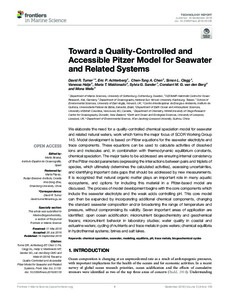| dc.contributor.author | Turner, David R. | |
| dc.contributor.author | Achterberg, Eric P. | |
| dc.contributor.author | Chen, Chen-Tung A. | |
| dc.contributor.author | Clegg, Simon L. | |
| dc.contributor.author | Hatje, Vanessa | |
| dc.contributor.author | Maldonado, Maria T. | |
| dc.contributor.author | Sander, Sylvia G. | |
| dc.contributor.author | van den Berg, Constant M. G. | |
| dc.contributor.author | Wells, Mona | |
| dc.date.accessioned | 2019-01-30T01:50:33Z | |
| dc.date.available | 2019-01-30T01:50:33Z | |
| dc.date.issued | 2016 | |
| dc.identifier.citation | Turner, D.R.; Achterberg, E.P.; Chen, C-TA;; Clegg, S.L.; Hatje, V.; Maldonado, M.T.; Sander, S.G.; van den Berg, C.M.G. and
Wells, M. (2016) Toward a Quality-Controlled and Accessible Pitzer Model for Seawater and Related Systems. Frontiers in Marine Science, 3:139, 12pp. DOI: 10.3389/fmars.2016.00139 | en_US |
| dc.identifier.uri | http://hdl.handle.net/11329/823 | |
| dc.identifier.uri | http://dx.doi.org/10.25607/OBP-379 | |
| dc.description.abstract | We elaborate the need for a quality-controlled chemical speciation model for seawater and related natural waters, work which forms the major focus of SCOR Working Group 145. Model development is based on Pitzer equations for the seawater electrolyte and trace components. These equations can be used to calculate activities of dissolved ions and molecules and, in combination with thermodynamic equilibrium constants, chemical speciation. The major tasks to be addressed are ensuring internal consistency of the Pitzer model parameters (expressing the interactions between pairs and triplets of species, which ultimately determines the calculated activities), assessing uncertainties, and identifying important data gaps that should be addressed by new measurements. It is recognised that natural organic matter plays an important role in many aquatic ecosystems, and options for including this material in a Pitzer-based model are discussed. The process of model development begins with the core components which include the seawater electrolyte and the weak acids controlling pH. This core model can then be expanded by incorporating additional chemical components, changing the standard seawater composition and/or broadening the range of temperature and pressure, without compromising its validity. Seven important areas of application are identified: open ocean acidification; micro-nutrient biogeochemistry and geochemical tracers; micro-nutrient behaviour in laboratory studies; water quality in coastal and estuarine waters; cycling of nutrients and trace metals in pore waters; chemical equilibria in hydrothermal systems; brines and salt lakes. | en_US |
| dc.language.iso | en | en_US |
| dc.rights | Attribution 4.0 | * |
| dc.rights.uri | https://creativecommons.org/licenses/by/4.0/ | * |
| dc.subject.other | Chemical speciation | en_US |
| dc.subject.other | Modeling | en_US |
| dc.subject.other | Equilibria | en_US |
| dc.subject.other | pH | en_US |
| dc.subject.other | Trace metals | en_US |
| dc.subject.other | Biogeochemical cycles | en_US |
| dc.title | Toward a Quality-Controlled and Accessible Pitzer Model for Seawater and Related Systems. | en_US |
| dc.type | Journal Contribution | en_US |
| dc.description.refereed | Refereed | en_US |
| dc.format.pagerange | 12pp. | en_US |
| dc.identifier.doi | https://doi.org/10.3389/fmars.2016.00139 | |
| dc.subject.parameterDiscipline | Chemical oceanography | en_US |
| dc.bibliographicCitation.title | Frontiers in Marine Science | en_US |
| dc.bibliographicCitation.volume | 3 | en_US |
| dc.bibliographicCitation.issue | Article 139 | |
| dc.description.bptype | Manual | en_US |
| dc.description.bptype | Guide | en_US |
| dc.description.frontiers | 2016-05-31 | |
| obps.contact.contactemail | david.turner@marine.gu.se | |
| obps.resourceurl.publisher | https://www.frontiersin.org/articles/10.3389/fmars.2016.00139/full | en_US |
 Repository of community practices in Ocean Research, Applications and Data/Information Management
Repository of community practices in Ocean Research, Applications and Data/Information Management

